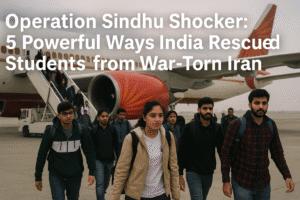Operation Sindhu Shocker: 5 Powerful Ways India Rescued Students from War-Torn Iran
Iran granted special airspace access for India to evacuate 1,000 students stranded by the Iran-Israel conflict, with the first Mahan Air flight arriving in Delhi. This urgent airlift is part of “Operation Sindhu”, launched after Indian medical students were injured in a Tehran dormitory strike. The operation began earlier with 110 students evacuated from northern Iran via a perilous road journey to Armenia, followed by a flight home.
Over 4,000 Indians remain in Iran, half being students. The Indian Embassy is actively relocating citizens from conflict zones to safer areas and coordinating departures, maintaining 24/7 emergency helplines. New Delhi expressed gratitude to Iran and Armenia for facilitating these life-saving corridors amidst intense hostilities. The operation highlights the precarious reality for civilians caught in geopolitical crises.

Operation Sindhu Shocker: 5 Powerful Ways India Rescued Students from War-Torn Iran
The stark headline – “Iran makes exception, opens airspace for evacuation of Indian students” – captures a critical moment in the ongoing Iran-Israel conflict, but the reality behind it is a complex tapestry of diplomacy, crisis management, and the profound relief of stranded citizens. This isn’t just a logistical footnote; it’s a human story unfolding amidst geopolitical fire.
The Lifeline Flight: In a significant gesture during heightened hostilities, Iran has granted special permission for its airspace to be used specifically for evacuating Indian students. Iranian carrier Mahan Air is operating chartered flights, with the first bringing approximately 1,000 students back to Delhi. This direct air corridor, established despite the conflict, represents a crucial exception and a vital lifeline. As one official simply stated, “We have scheduled these chartered flights for the Indians those who want to get out.” The first flight’s arrival in Delhi signifies the tangible outcome of intense diplomatic efforts.
Operation Sindhu: A Multi-Pronged Rescue: The Mahan Air flights are the latest, most visible phase of “Operation Sindhu,” launched by India on June 19th. This operation was spurred by alarming reports, including injuries to Indian students in a strike on a Tehran medical dormitory. The Indian Embassy in Tehran confirmed close coordination with Iranian authorities following this incident.
The evacuation strategy has been multifaceted and resourceful:
- Northern Exodus: Even before official operation naming, the Embassy facilitated the evacuation of 110 students from northern Iran. They undertook a perilous road journey into Armenia, escorted by Indian officials from Tehran and Yerevan.
- Armenian Gateway: These students were then flown out of Yerevan on a special flight on June 18th – the quiet beginning of the evacuation effort.
- Direct Airlift: The opening of Iranian airspace now enables the direct, large-scale evacuation via Mahan Air, drastically speeding up the process for those concentrated in Tehran and other accessible areas.
The Human Dimension: Behind the numbers – over 4,000 Indian nationals in Iran, half of them students – lie individual stories of fear, uncertainty, and resilience. The attack on the Keshavarz street dormitory brought the conflict terrifyingly close to Indian citizens pursuing their education. Operation Sindhu prioritizes getting these young people, and other vulnerable nationals, out of harm’s way. The Indian Ministry of External Affairs (MEA) reiterated that the safety and security of Indians abroad remains the “highest priority.”
Challenges and Gratitude: The MEA acknowledges the immense difficulty of the task. Embassy staff are actively helping Indians relocate from conflict hotspots within Iran to safer zones, coordinating complex movements amidst unpredictable warfare. New Delhi has expressed sincere gratitude to both Iran and Armenia for their crucial cooperation in facilitating these life-saving corridors.
Ongoing Vigilance: For the thousands of Indians still in Iran, the situation remains fluid and precarious. The Indian Embassy in Tehran maintains a 24/7 emergency helpline, and the MEA’s Control Room in Delhi operates round-the-clock, serving as a vital nerve center for information and assistance. The message is clear: stay connected, stay informed.
Why This Matters Beyond the News Cycle:
- Diplomatic Leverage: Iran’s specific exception for Indian evacuation flights highlights India’s diplomatic standing, even with nations engaged in active conflict. It underscores a channel of communication and a degree of trust utilized in crisis.
- Evolving Evacuation Playbook: Operation Sindhu demonstrates India’s growing experience and capability in complex evacuations, blending road convoys, third-country hubs (Armenia), and direct chartered flights under fire – a refined approach learned from past crises like Ukraine.
- The Student Exodus: The focus on students highlights the global nature of education and the vulnerability of young citizens caught far from home in sudden conflict. Their safe return alleviates immense anxiety for families across India.
- The Cost of Conflict: The injuries sustained by Indian students are a stark reminder that modern conflicts have far-reaching, unintended victims, impacting international students and workers simply living their lives.
The Takeaway: The image of Mahan Air flights landing in Delhi carrying Indian students is a powerful symbol of successful crisis management and international cooperation under duress. “Operation Sindhu” is more than just an evacuation; it’s a testament to the relentless effort to bring citizens home when the world turns dangerous. While the airlift is a major step, the operation continues until every Indian who wishes to leave is safely out, a sobering reminder of the human cost paid when geopolitical tensions ignite.
You must be logged in to post a comment.